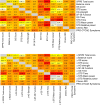Effect of resistance training on physical function during chemotherapy in colon cancer
- PMID: 39012500
- PMCID: PMC11285783
- DOI: 10.1093/jncics/pkae058
Effect of resistance training on physical function during chemotherapy in colon cancer
Abstract
Background: The decline of physical function during chemotherapy predicts poor quality of life and premature death. It is unknown if resistance training prevents physical function decline during chemotherapy in colon cancer survivors.
Methods: This multicenter trial randomly assigned 181 colon cancer survivors receiving postoperative chemotherapy to home-based resistance training or usual care control. Physical function outcomes included the short physical performance battery, isometric handgrip strength, and the physical function subscale of the Medical Outcomes Short-Form 36-item questionnaire. Mixed models for repeated measures quantified estimated treatment differences.
Results: At baseline, participants had a mean (SD) age of 55.2 (12.8) years; 67 (37%) were 60 years or older, and 29 (16%) had a composite short physical performance battery score of no more than 9. Compared with usual care control, resistance training did not improve the composite short physical performance battery score (estimated treatment difference = -0.01, 95% confidence interval [CI] = -0.32 to 0.31; P = .98) or the short physical performance battery scores for balance (estimated treatment difference = 0.01, 95% CI = -0.10 to 0.11; P = .93), gait speed (estimated treatment difference = 0.08, 95% CI = -0.06 to 0.22; P = .28), and sit-to-stand (estimated treatment difference = -0.08, 95% CI = -0.29 to 0.13; P = .46). Compared with usual care control, resistance training did not improve isometric handgrip strength (estimated treatment difference = 1.50 kg, 95% CI = -1.06 to 4.05; P = .25) or self-reported physical function (estimated treatment difference = -3.55, 95% CI = -10.03 to 2.94); P = .28). The baseline short physical performance battery balance score (r = 0.21, 95% CI = 0.07 to 0.35) and handgrip strength (r = 0.23, 95% CI = 0.09 to 0.36) correlated with chemotherapy relative dose intensity.
Conclusion: Among colon cancer survivors with relatively high physical functioning, random assignment to home-based resistance training did not prevent physical function decline during chemotherapy.
Clinical trial registration: NCT03291951.
© The Author(s) 2024. Published by Oxford University Press.
Conflict of interest statement
Dr Brown is supported by R00CA218603, R01CA270274, U01CA271279, and OT2CA278684. Dr Brown reports receiving consulting fees from Novo Nordisk A/S. Dr Meyerhardt is supported by the Douglas Gray Woodruff Chair fund, the Guo Shu Shi Fund, the Project P fund, Anonymous Family Fund for Innovations in Colorectal Cancer, and the George Stone Family Foundation. All other authors declare no competing interests.
Figures


References
-
- Scheepers ERM, Vink GR, Schiphorst AHW, et al. The impact of surgery and adjuvant chemotherapy on health-related quality of life in patients with colon cancer: Changes at group level versus individual level. Eur J Cancer Care (Engl). 2022;31(6):e13691. - PubMed
-
- Kluetz PG, Slagle A, Papadopoulos EJ, et al. Focusing on core patient-reported outcomes in cancer clinical trials: symptomatic adverse events, physical function, and disease-related symptoms. Clin Cancer Res. 2016;22(7):1553-1558. - PubMed
-
- Quinten C, Coens C, Mauer M, et al. ; EORTC Clinical Groups. Baseline quality of life as a prognostic indicator of survival: a meta-analysis of individual patient data from EORTC clinical trials. Lancet Oncol. 2009;10(9):865-871. - PubMed
Publication types
MeSH terms
Associated data
Grants and funding
LinkOut - more resources
Full Text Sources
Medical
